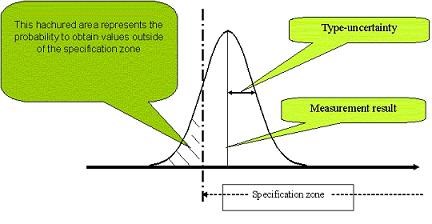Uncertainty of measurement concept in European Standards
This page gives guidance and provides a checklist to assess the need for implementation of the uncertainty of measurement concept in standards and guide TCs through their decision process.
1 BACKGROUND
When possible and necessary, the Technical Board of CEN (BT) asks CEN technical bodies and other relevant bodies to implement the guidance and recommendations about uncertainty of measurement (see below) within the limits allowed by available resources and without compromising the need to deliver European Standards as quickly as possible (resolution BT 21/2003).
It is of common knowledge that measurement results are never perfectly accurate. In practice the sources of systematic and random errors which can affect the results of measurement are numerous (even for the most careful operators).
To describe this lack of perfection, the term "uncertainty" is used. Although the concept of uncertainty may be related to a "doubt", in the real sense the knowledge of uncertainty implies increased confidence in the validity of results.
The figure below illustrates the decision difficulty when uncertainty could affect the compliance of a product to a specification limit (this figure illustrates the case of a Gaussian distribution, but the difficulty is the same in the case of all other kinds of distribution).

This margin of doubt should be quantified to be able to make a consistent decision. In fact a key consideration is the degree of risk associated with the decision making process.
Without knowledge of the accuracy (trueness and precision) of measurement methods and/or the uncertainty of measurement results, it may appear very easy to make decisions. But, in practice, these decisions may be incorrect and sometimes lead to serious consequences, if the measurement uncertainty is not taken into account.
For example, in the economical field, when rejecting instead of accepting a good product during a certification process or, conversely, when accepting a bad product by error. In the legal field, when returning a verdict of guilty instead of not guilty in case of market surveillance or of accident. In the human field, when falsely classifying dangerous products as safe. In the ethical field, when having overly optimistic or unduly pessimistic interpretation of results leading to a non - fair competition between manufacturers and between testing laboratories, etc.
So, it is vital to quantify the reliability of the measurement results to greatly reduce any disputes and adverse consequences of legal proceedings. This is of particular importance if we consider the growing number of cases of litigation in Europe and the liability problems of manufacturers in case of accidents.
2 POLICY GUIDANCE
The assessment for possible introduction of 'Uncertainty of measurement' into standards should be carried out by the Technical Committees (TCs) (Working Group (WG), Subcommittee (SC), Joint WG, Project Committees, etc.) before creation of a new work item (WI).
The assessment should be conducted using the checklist provided below. CEN/BT WG 122 'Uncertainty of measurement' in researching this topic on behalf of CEN made some recommendations and proposals presented at the 53rd CEN/BT meeting in Brussels, 2003-04-23/24.
The CEN/BT, noting the report (BT N 6831) and its recommendations, decided to ask CEN technical bodies and other relevant bodies to be aware of the guidance and recommendations contained in that report.
3 CHECKLIST
|
Uncertainty of Measurements in Standard |
Questions |
Yes |
No |
If ...then ...else |
|
1 |
Do you intend to draft a standard for product specifications and measurement or for measuring methods ? |
|
|
If no then go to 7 else go to 2 |
|
2 |
Could the absence of information on Uncertainty of measurement lead to possible disputes and negative consequences ? |
|
|
If no then go to 6 else go to 3 |
|
3 |
Can this work be achieved without delaying the overall time frame for European Standard production ? |
|
|
If no then go to 6 else go to 4 |
|
4 |
Do you have experts in your TC that could deal with the uncertainty of measurements aspects ? |
|
|
If no then go to 6 else go to 5 |
|
5 |
You could consider to deal with uncertainty of measurement in your standard |
|
|
- |
|
6 |
Annex to your standard the 'Measurement of uncertainty' leaflet published by the 'Swedish National Testing and Research Institute' (see 5.1.3). |
|
|
- |
|
7 |
No inclusion of 'Uncertainty of measurement' concept is necessary |
|
|
- |
4 LABORATORIES
- EA: European Co-operation for Accreditation Laboratory - Website
- EURACHEM: Establishing system for the international traceability of chemical measurements - Website
- Euro lab a.i.s.b.l: European federation of national associations of measurement, testing and analytical laboratories - Website
- EURAMET: European Association of National Metrology Institutes - Website